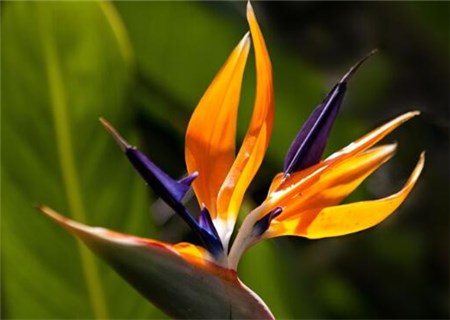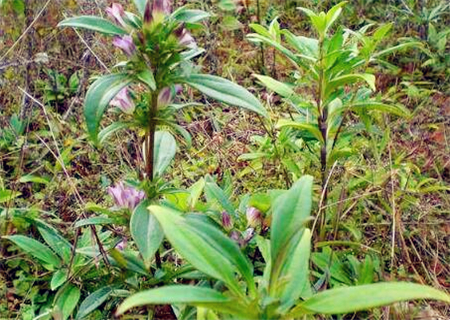Orchids (also known as Chinese orchid) what are the common varieties? How to raise talent exuberant?
Orchid is a unique style of flowers, its ornamental value is very high. The flowers and colors of orchids are light and elegant, most of which are tender green, yellow and green, but especially those with a vegetarian heart. So do you know what common species of orchids are? How to keep it exuberant?

I. what are the common varieties of orchids
1. Chunlan
Chunlan, also known as grass orchid, mountain orchid, blossoming incense, referred to as orchid, the ancients called it weak feet. The villagers in Lanshan District are called Xiaolan.
Cymbidium is the most widely distributed orchid in China, with the most abundant resources, long cultivation history and the largest number of horticultural varieties. Its plant is small, the leaf is narrow, the pedicel is erect, the height is about 6mur25cm, and it has a flower. The ancients called an orchid with a stem and a flower. A small number of people with double flowers are called Bingtilan, which means auspicious. Although the plant of Cymbidium is small, the flower is larger. The diameter of the flower is generally 4mi 6cm, and the maximum diameter is 8cm. The flowers are usually green and yellowish green, with purplish red stripes or spots on the perianth. The florescence is about one month (from mid-February to mid-March). Most of the orchids have fragrance, known as fragrance.
Chunlan has its own characteristics due to different producing areas, which can be divided into Jiangsu and Zhejiang Chunlan, Henan Chunlan, Hubei Chunlan, Yunnan, Guizhou, Sichuan inland Chunlan, southern Chunlan and so on.
2. Spring Sword
The main resource areas of Chunjian are in Sichuan and Guizhou. Spring sword plant shape is tall, the leaf width is 1 Mel 2.2 cm, the leaf length is 40-100 cm, the leaf quality is like Chunlan, the leaf shape is majestic. The flowering period is also the same as that of Chunlan, with 2 to 5 flowers per peduncle, with a diameter of 4mur8 cm, rich and colorful flowers, thinner petals with obvious hidden lines on the petals, with a better fragrance. The plant is strong and usually has 10 leaves. The roots are thick and strong. The traditional famous species include "Dahong cinnabar", "Silver Bar", "Longchang Su", "Xishu Daoguang" and so on. In recent years, a large number of new varieties have been selected to form the characteristics of Sichuan orchid.
3. Lotus petal orchid
Also known as Xiao Xue Lan, Beyalam. The distribution area is very narrow, and there are only native species in the western Yunnan and alpine areas of Taiwan.
Nelumbo nucifera leaves are slender and narrow, with a leaf length of 50 mi 80 cm and a leaf width of 0.5 mi 1.2 cm. The leaves are clustered with 9 pieces, the pseudobulb is small, the diameter is only about 1 cm, but the root is stout, the diameter is about 0.5 cm. The pedicel is erect, thin, round and erect, bearing 3 flowers, the petals are thin, the hidden stripes on the perianth are obvious, and the flower spreading diameter is about 3.5 Mel 6 cm. Sepals lanceolate, petals long ovate, lips rolled up and down. The flowering period is from January to March, the flowers bloom and the fragrance is rich and elegant. Representative varieties are "Da Xue Su" and "Xiao Xue Su". The color of the lotus orchid is as white as snow, which forms a sharp color contrast with the green leaves.
4. Cymbidium
Also known as Jiuhualan, Jiujie Orchid, Jiuzilan, the villagers of Lanshan District are called Gaolan, Dalan, Niulan and Shanglan. The ancients called one stem and nine flowers as Huihua, also called Cymbidium but not Huilan. A few areas are called Xialan or send spring.
The plant of Cymbidium is generally tall, with 5-13 leaves, about 35-80 cm in length and 0.5-1.5 cm in width. The veins of the leaves are thick and obvious, the leaf margin is serrated obviously and thicker, and the pseudobulm is not obvious. Pedicel erect, pedicel diameter 1 cm, thin, such as line incense, tall even leaf frame or leaf frame, generally about 35 mi 80 cm high. There are 30 flowers in 5mure. The diameter of the flower is about 3.5 mi 8 cm. The flower color is more yellow-green or emerald-green, with green velvet fur on the tongue and many purple-red dots on it. The florescence is from April to early May, and occasionally blossoms again in autumn. Cymbidium flowers are widely distributed, and also distributed to the north of Qinling Mountains. The altitude of the native place is higher than that of Chunlan, and it is more cold-resistant, dry-resistant and sunny.
The leaf shape and flower quality of cymbidium produced in different places are slightly different, which can be divided into Jiangsu and Zhejiang, western Anhui and Hubei, Yunnan, Guizhou, Sichuan inland and southern cymbidium, etc.
5. Mo Lan
Also known as New year orchid, happy New year Orchid, Fengshi Orchid. The leaves of Cymbidium are broad, generally up to 2 mi 4.2 cm wide and about 25 mi 80 cm long. 2Mel 5 leaves were planted on the pseudobulm. The pseudocorm is larger, 1.5-2.5 cm in diameter. The leaves are glossy, the cross section is shallow "y" shaped or spreading, and the leaf margin is usually unserrated. Pedicels erect, usually higher than leaf frame. Raceme, with more than 5-20 flowers, flowers spreading about 2.5 cm in diameter. Sepals and flowers usually narrowly lanceolate, lips pendulous. The color of the flower is mostly lavender brown, decorated with dark purple brown stripes. The flowering period is from late autumn to February of the following year, with sweet aroma.
Cymbidium grows in Fujian, Guangdong, Guangxi, Taiwan, Jiangxi, Yunnan, Hainan, Sichuan and southern Guizhou to the south of latitude 26 °N. according to its characteristics, it can be divided into Taiwan, Daming, Guangdong, Yunnan, Jiangxi and so on.
6. Dendrobium
Dendrobium orchid in many orchids, strong nature, with a peaceful and amiable temperament, known as the "father's flower." Dendrobium orchid is epiphytic in tree trunks or tree holes, and its flowers and colors are varied, but mainly white and purple. Dendrobium blossoms in spring and has strong cold resistance. It has curative effect on human body, such as expelling deficiency heat, tonifying essence and strengthening yin.
7. Leopard orchid
Leopard orchid leaves thickly leathery, dark green above, light green abaxially, distichous, banded, 20-25 cm long and 2.5-3.5 cm wide, apex unequilateral 2-lobed, base decurrent into clasping sheaths. Its florescence is from March to May every year. Leopard orchids are native to Taiwan and often grow in low-altitude mountain forests. nowadays, leopard orchids are also planted in Japan and the Philippines. It is a very rare orchid species.
Second, how to grow orchids in order to flourish
1. Fertilizer
Although it needs to be planted with orchid mud at first, the nutrients are not enough in the long run and need to be replenished by fertilization. The requirements for fertilization are stricter, more is not enough, less is not enough. First of all, just grow buds and leaves, you need to apply a N-based fertilizer. Then comes the period of exuberant growth, specifically from May to the Beginning of Autumn, where nitrogen fertilizer is used every two weeks or half a month. After that, the application can be stopped. However, in the meantime, it needs to be added once after the flowers have faded. In addition, the specific time should also be paid attention to, preferably in the evening.
2. Moisture
Perhaps some friends have heard such a saying, "dry orchid wet chrysanthemum". Therefore, naturally, there can not be too much moisture. A small amount of water can make it thrive, but not too much. Generally speaking, it is best to keep 20% dry and 80% wet. It can not only meet its need for water, but also will not cause harm. Be careful not to water it at noon.
3. Light
Although this plant likes shade, it will not be exuberant for a long time. In spring and summer, it can be properly shaded. However, in autumn and winter, it is best to put it outside to bask in the sun for half a day. In this way, the plant is more prosperous. And, in order to let each side receive light evenly, it is best to adjust its orientation after a period of time to avoid differences in growth state.
4. Temperature
This aspect is very simple, and it is best to keep it within the appropriate scope. Specifically, it is 20 to 25 degrees, which is conducive to its exuberant growth.
Time: 2019-03-17 Click:
- Prev

How much is the market price of the herbal gentian? What is the prospect of artificial cultivation? Do you make money by planting?
The root and stem of gentian can be used as medicine. It tastes bitter, is cold, and specializes in clearing heat, dryness and dampness. Its effect of purging liver and gallbladder is very strong, and it can relieve wind and stop spasm and relieve pain. So how much is the market price of gentian grass per jin? What is the prospect of artificial cultivation? Do you make money by planting? Planting Prospect of Gentiana Gentiana is a perennial herb
- Next

Nayun Town, Pu'er City: launching a thousand mu "colorful Peanut planting Project" to help overcome poverty
Recently, according to the industrial development plan for getting rid of poverty at the beginning of the year, Nayun Town has launched a poverty alleviation project for short-term industrial poverty alleviation and income increase of thousands of mu of colorful peanuts. The town plans to plant 1630 mu of colorful peanuts, and the industrial project covers more than 1200 households that set up files and set up cards. It is expected that in five months' time.
Related
- Fuxing push coffee new agricultural production and marketing class: lack of small-scale processing plants
- Jujube rice field leisure farm deep ploughing Yilan for five years to create a space for organic food and play
- Nongyu Farm-A trial of organic papaya for brave women with advanced technology
- Four points for attention in the prevention and control of diseases and insect pests of edible fungi
- How to add nutrient solution to Edible Fungi
- Is there any good way to control edible fungus mites?
- Open Inoculation Technology of Edible Fungi
- Is there any clever way to use fertilizer for edible fungus in winter?
- What agents are used to kill the pathogens of edible fungi in the mushroom shed?
- Rapid drying of Edible Fungi

